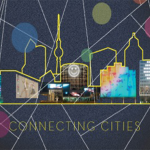The Speaker: Susa Pop is an urban media curator and producer based in Berlin. In 2003 she founded Public Art Lab (PAL) as a network of experts from the fields of urban planning, new media arts and IT. Susa Pop is interested in creative city-making through urban media art projects that catalyze communication processes in the public space. She initiated most of the PAL projects like the Connecting Cities Network (2012-16), Media Facades Festivals Berlin 2008 and Europe 2010, Mobile Studios (2006) and Mobile Museums (2004). She also speaks worldwide at conferences and workshops and is a lecturer at several universities like University of Potsdam and Leuphana University / Institute of Urban and Cultural Area Research. In 2012 Susa Pop co-edited and published the book Urban Media Cultures.
Tyler Clements Adam Harden George Hull Gregory Mania Nelesi Rodriguez
Urban Screens as community platforms: A reflection on the boundaries, the potential, and the challenges of this medium
Probably the first image that comes to mind when one hears the expression “urban screen” is one of Times Square: intrusive, stereotypical, offensive, manipulative, superficial, and wasteful. Yet even if the Times Square-style spectacle is indeed one example of urban screens, this medium needn’t be reduced to an advertising tool for corporations.
Susa Pop, urban media curator and managing director of the Berlin Public Art Lab, gave a presentation in an Understanding Media Studies lecture at The New School, in which she talked about urban screens as community platforms. She defines these devices as “membranes that are between the urban space and the digital world”. She also identifies the phenomenon as an index of gentrification – they tend to appear with commercial development and increasing property values — a situation that raises questions about the relationship between these projects and the communities in which they are created. According to Susa Pop, these “membranes” can have different sizes and looks. She categorizes the display`s formats as follows: Urban Screens (i.e. billboards), Media Façades (i.e. projections on buildings walls), Media Architectures (using not only the wall, but the whole building as structure for projection and interaction), and Urban Media (i.e. mobile cellphones).
Nicholas Mason Iimani McKnight Jewel Li Ryosuke Date Sean Landers
